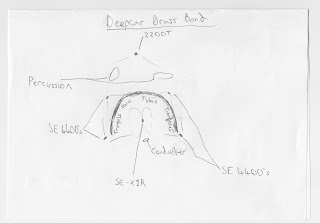When I started this project, I knew it would be a challenge for me as I had never recorded anything except bands, singer songwriters or my own electronic projects. So this post will explain the way I went about completing this project.
This brass band is located in a suburb of Sheffield and usually preforms covers of popular songs in a brass band style. They did not give a reference track, nor gave any instructions to how they wanted to sound; therefore I researched popular brass band recording techniques. I first researched recording big bands, this source helped me understand the basics of recording brass instruments as a band, such as letting the members hear themselves such as if they were practicing with their band. However I found this source to be mostly ineffective because the way I was going to record them, due to restrictions with equipment and recording spaces, was to record the band live, not separate like this source explained. I then found a source on theMouthPiece.
“When I recorded a CD with Saltash, they used 2 mics at the front of the band, one or two at the back to pick up the percussion and general back of the band; and one as used as a solo mic”
This informed me that a respectable way to record a brass band was to use 4 stereo mics (front and back of the band) to pick up the individual sections, and also one mic at the back of the room to pick up the overall sound.
For the recording process, I decided to use the recording technique stated by the article on theMouthPiece, as well as adding some experimental techniques of my own. I used 4 large condenser mics, 2 at the front capturing the trombones and trumpets, and 2 at the back capturing the tubas and other bass brass instruments. I did this because it captured each section well, helping me split each individual section when mixing.
I also used a figure of 8 ribbon mic in the middle of the band because the mic had a very natural tonal quality to it, and I thought this could be used as an overall sounding close mic for all the bands instruments.
Finally I used a tube mic at the back of the room (also close to the percussion) because the mic has a warm sound to it which I thought would work well capturing the room sound, as well as the full sound of the percussion, which it also acted as a close mic for, when the other mics hardly picked them up at all. This ended as a very good selection of mics and positions, all complimenting each other respectively.

In the mixing process, I started by panning the front stereo mics 100% and the back stereo mics about 75% each way. This was because it would eventually add a wide stereo sound, complimenting the whole sound of the band, as if an audience member would be listening to them. It also helped separate each section so they were all easily present in the full mix. The next stage was to EQ the individual mic’s. The centre ribbon mic was EQ’d raising the low and high end frequencies. I did this because I wanted it to represent the low frequencies of the tubas and trombones, whilst simultaneously bringing out the high frequencies of the trumpets and horns. The front and back stereo mic’s were EQ’d to represent the instruments they were facing. The front mic’s had raised high and low mids because this was where the trumpets, horns and trombones were positioned, bringing out their natural tones. Whilst the back mic’s were EQ’d bringing out the low end frequencies of the tubas, exciting the tones they created. I EQ’d the back of the room mic because I wanted to take out the problematic frequencies of the room, whilst attempting to make the percussion (which were positioned close by) stand out. I also slightly compressed this mic because it would in turn keep the percussion sounding dry, however raising the level of the room sound when the percussion were not being played, bringing out the natural ambience of the environment in which the brass instruments were played. Lastly I added a long hall reverb (mixed 20%) to the master because it made all the instruments blend nicely, creating a much more glued together mix.
In the mastering stage, I reduced the high end because I found the cymbals became harsh and overpowering at times. I then raised the low end and high mid to create a much more natural sound to the mix. As brass band music is not a popular and contemporary style of music, as well as being based around varied dynamics, I did not compress or maximise the track too much. I did this so the track had a much more dynamic and natural sound, such as the way in which they preform in public.
To conclude, my micing and mixing/mastering techniques paid off as the overall sound kept to the themes of the genre, as well as creating a well balanced and blended mix. All the instruments kept their clarity, and there were no problematic frequencies in the overall mix.
Comments are closed.
